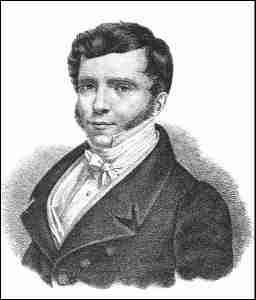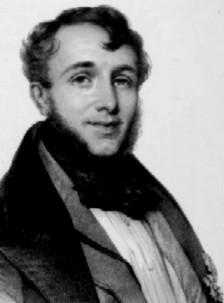<Back to Index>
- Astronomer Edmond Halley, 1656
- Composer Friedrich Wilhelm Michael Kalkbrenner, 1785
- King of Siam Rama VII, 1893
PAGE SPONSOR


Friedrich Wilhelm Michael Kalkbrenner (November 2–8, 1785 – August 10, 1849) was a German pianist, composer, piano teacher and piano manufacturer who spent most of his life in England and France. Before the advent of Frédéric Chopin, Sigismond Thalberg and Franz Liszt, Kalkbrenner was by many considered to be the foremost pianist in France and England, even Europe. The only serious rival he had was Johann Nepomuk Hummel. Kalkbrenner was a prolific composer of a multitude of piano works (altogether more than 200), piano concertos, and even operas.
Author of a famous method of piano playing (1831) which was in print until the late 19th century, he ran in Paris what is sometimes called a factory for aspiring virtuosos and taught scores of pupils from as far away as Cuba. His best piano pupils were Marie Pleyel and Camille - Marie Stamaty. Through Stamaty Kalkbrenner’s piano method was passed on to Louis Moreau Gottschalk and Camille Saint - Saëns. He was one of the few composers who through deft business deals became enormously rich. Chopin dedicated his first piano concerto to him. Kalkbrenner published transcriptions of Beethoven's nine symphonies for solo piano decades before Liszt did the same. He was the first one to introduce long and rapid octave passages in both hands – today so familiar from 19th century piano music - into his piano texture. Today he is not so much remembered because of his music, but because of his alleged vanity. Kalkbrenner was convinced that, after the death of Mozart, Beethoven and Haydn, he was the only classical composer left, and he never hesitated to let the world know this. Although of humble origins, he had a lifelong aspiration to be an aristocrat and delighted in rubbing shoulders with the nobility in London and Paris. He is invariably described as a somewhat pompous, formal, overly polite, yet intelligent and business wise extremely shrewd man. He was the target of many anecdotes already during his own lifetime and bitingly satirized by the German poet Heinrich Heine. There hardly is any other composer who lives on in so many anecdotes and stories as Kalkbrenner. Virtually nothing of his huge output survived, although recently several pianists have taken some shorter works of his in their repertoire. A new recording of two of his piano concertos (No. 1 and No. 4) was released in 2005, an older (and abridged) recording of the piano concerto No. 1 is still available.
Friedrich Wilhelm Kalkbrenner was the son of Christian Kalkbrenner and a (so far) unnamed mother. Kalkbrenner was born, allegedly in a post chaise, during a trip his mother made from Kassel to Berlin. The exact date of his birth could never be established, not so much due to the fact that Kalkbrenner’s parents would not know, but simply because his birth could not be registered with the authorities as the mother was en route. Kalkbrenner’s father was going to be appointed Kapellmeister to Frederica Louisa of Hesse - Darmstadt, Queen consort of Prussia, in 1786. Thus it is possible that Kalkbrenner’s mother was on the way from Hesse to Berlin to join her husband who would shortly take up his new duties at the court of Potsdam.
Kalkbrenner’s own father was his first teacher. The boy must have progressed rapidly. By the time he was six he played a piano concerto by Joseph Haydn to the Queen of Prussia. When he was eight he spoke four languages fluently. Although his education must have been privileged and took part in beautiful, even dreamy surroundings in Potsdam and Rheinsberg castle, Kalkbrenner retained the heavy Berliner argot, characteristic of working class people to this day, for the rest of his life.
At
the end of 1798 Kalkbrenner was enrolled at the Paris conservatoire. He
was in the piano class of Alsatian pianist and composer Louis Adam, father of the now more famous opera composer Adolphe Adam. Louis Adam was for 45 years the most influential professor for piano at the Paris Conservatory. According to French pianist and piano professor Antoine François Marmontel, he
put his pupils to work on great masters like Bach, Handel, Scarlatti,
Haydn, Mozart, and Clementi - at that time a notable exception among
piano teachers. In harmony and composition he was taught by Charles Simon Catel. Kalkbrenner was a fellow student of opera and ballet composer Ferdinand Hérold. Kalkbrenner did well at his studies. In 1800 he won second prize for piano (Pierre - Joseph - Guillaume Zimmermann came
in first), in the following year first prize. When he left Paris at the
end of 1802 for Vienna to continue his studies, Kalkbrenner was not yet
a finished artist, but he could already look back on a solidly musical
education from recognized masters in their own fields.
In the latter half on 1803 Kalkbrenner travelled to Vienna to continue with his education. It is not yet clear why he took this step, it could be that he assumed that he wanted to crown his studies with lessons from some representative of the Viennese Classical School. It must have been easy for him anyway because he spoke German as his native language and he probably had help from his father who was a known musical personality in the Austrian capital.
In Vienna he took counterpoint lessons from Johann Georg Albrechtsberger, then already quite old, but the eminence
in Austrian music theory and the finest contrapuntist of his day. Moreover, Albrechtsberger had been the teacher of Beethoven, Carl Czerny, Hummel, Ignaz Moscheles, Josef Weigl, and Ferdinand Ries,
and he was a close friend of Josef Haydn. Who better was there to claim
as his teacher for an impressive resume, especially for one like
Kalkbrenner, who always had his eye on wealth and fame? Besides taking
lessons in counterpoint he saw a lot of Haydn, Beethoven and Hummel,
playing duets with the latter, his only serious rival as a pianist.
Thus, it is not entirely without warranty when Kalkbrenner styled
himself as the last classical composer for the rest of his life. He
firmly maintained that he was of the old school, and the old school was
Beethoven, Haydn, Ries and Hummel.
With
his educaction finally ended, Kalkbrenner in 1805 and the year
thereafter appeared as concert pianist in Berlin, Munich, and Stuttgart. From
1814 to 1823 Kalkbrenner lived in England. He gave a good many
concerts, composed and established himself as a successful piano
teacher. It was here that Kalkbrenner, always the astute businessman,
came across an invention made by one Johann Bernhard Logier. This
invention was the so-called chiroplast or hand guide.
The chiroplast was a contrivance made from two parallel rails of
mahogany wood that were placed on two feet and loosely attached to the
piano. This apparatus should restrict vertical motions of the arms
thereby helping nascent pianists to attain the (perceived) correct
position of the hands. Camille Saint - Saëns, who was put to work
with it as a boy, describes it: Useful
or not, this contraption became a runaway success. There are reports
that it was still available for sale in London in the 1870s. In 1817
Logier teamed up with Kalkbrenner to found an academy where music
theory and piano playing, of course with the help of the chiro-plast,
were taught. The
proceeds from the patent made Kalkbrenner a wealthy man. In 1821 Ignaz
Moscheles had also settled in London. His powerful and finished playing
had a great influence on Kalkbrenner, who used his time in London to
hone his technical skills even more.
In
1823 and 1824 Kalkbrenner gave concerts in Frankfurt, Leipzig, Dresden,
Berlin, Prague, and Vienna. Where he went he was received with loud
applause. Considering the fact that Ignaz Moscheles,
who was wider known, Kalkbrenner's equal as a pianist, and a better
composer, was touring the same places at roughly the same time, this
was quite an achievement. It would be wrong to classify Kalkbrenner as the Theodor Leschetizky of his time, but he had quite a few pupils and some of them became fine pianists and sometimes also good composers. Through Arabella Goddard and Camille Saint - Saëns – who studied with Kalkbrenner’s star product Camille - Marie Stamaty –
Kalkbrenner’s influence reached well into the first half of the 20th
century. This is a list of Kalkbrenner’s most famous students: